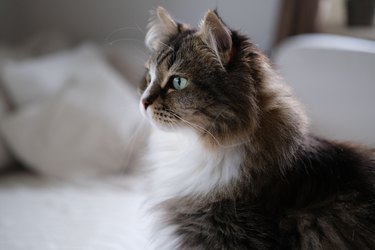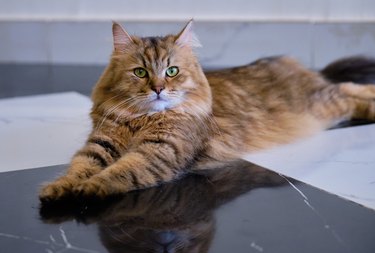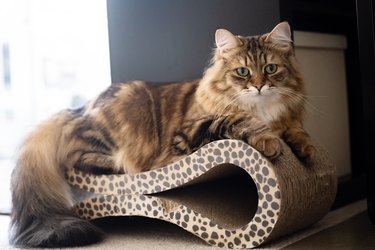
Siberian cat quick facts
Length: 15 - 18 inches
Weight: 17 - 26 pounds, males tend to be larger than females
Video of the Day
Video of the Day
Lifespan: 11 - 18 years or more
Coat length: Long
Coloring: All colors and coat patterns including tortoiseshell and colorpoint
Grooming needs: Medium
Friendliness: Breed alone is not an accurate predictor of individual cats' personalities. However, Siberian cats are generally regarded as playful and affectionate.
The Siberian cat is the national cat of Russia. They are medium to large, with long hair. While they have a long coat, the cats may be more hypoallergenic than other cat breeds. This can be beneficial if a family member is an allergy sufferer. Siberians are also known for their playful and affectionate nature. They have a calm demeanor and they don't tend to be overly demanding.
Siberian kittens can take up to five years to reach their full size and maturity. Adult cats can be medium-sized but may also get quite large, weighing as much as 26 pounds. The breed standard puts more emphasis on the cat's muscular build and big bones over their exact weight.

Siberian cat history
The Siberian cat also called a Siberian forest cat or Moscow longhair is a Russian cat breed with references to the cats found as early as 1000 AD. They are included in many books including some Russian fairy tales and the 1889 book "Our Cats and All About Them" by Harrison Wier.
The cats are native to Siberia in the forests of Russia. Despite the breed's long history, there is minimal documentation. It wasn't until the 1980s that more extensive records were kept in Russia.
The Siberian cat breed was accepted into the International Cat Association in 1992 and received championship status in 1996. Siberians were first brought to the United States in 1990 by a cat breeder named Elizabeth Terrell. They were accepted into the Cat Fanciers' Association in 2000 where they later received championship status in the organization's cat shows in 2006.
Siberian cat personality
Siberian cats have wonderful personalities that make them a welcome addition to any home. They are affectionate and love to be with the family, including children and other pets. A Siberian cat may even follow you around as you move to different rooms. They love to cuddle when you are relaxing but they are far from being couch potatoes.
The breed is very intelligent and playful. Take the time to play with your cat and enjoy the cat's antics as they jump and flip in pursuit of the toy. You should always make the game fun for your cat and let them "win" at chasing the toy. Be sure to avoid laser pointers — these can potentially injure and frustrate cats.
You may also find your Siberian kitten or cat climbing bookcases and attempting to jump to high perches. Provide them with a cat tree and shelves to climb. These will give them more room to jump around and play.
The Siberian cat breed is also sometimes recommended as a therapy or support animal. These cats tend to be easygoing and undemanding. They are willing to give affection and support when they sense emotional distress. The cats also communicate vocally. They have a soft meow and also often trill, chirp, and purr.

Siberian cat lifespan & health issues
Healthy Siberian cats tend to have a long lifespan and can live well into their teen years. As with many other cat breeds, they are at risk for hypertrophic cardiomyopathy (HCM). This is a type of heart disease that causes a thickening of the heart muscle. A veterinarian can check for this condition with echocardiography.
Keep the Siberian up to date on all their vaccinations and have regular checkups with your veterinarian so that you can address any potential health problems right away.
Siberian cat grooming & care
Siberian cats have long, thick coats that are water-resistant. They evolved to withstand the harsh winters of the Siberian forests. They have a triple coat with an undercoat, awn hairs, and guard hairs. You will see a ruff around the cat's neck and thick fur on the britches or hind legs. Some cats may have a lynx tipping on their ears.
Fortunately, the coat of this long-haired breed doesn't tend to develop tangles and mats. Ideally, you should brush the cat at least once per week, making sure to comb the undercoat as well. When the Siberian cat is shedding their winter coat, they need daily brushing to remove loose fur. You don't need to bathe the cats, but the breed is dog-like in their love of water. Your cat may appreciate an occasional bath.
While no cat is truly hypoallergenic, the Siberian cat breed may be less likely to trigger an allergic reaction compared to other cat breeds. This is likely due to the fact that Siberian cats produce less of the FelD1 protein which is an allergen in the cat's saliva and dander that may trigger a reaction in some individuals in some individuals.
In addition to regular grooming, make sure to check and trim your cat's nails regularly. Clean the ears and brush their teeth with pet toothpaste. Feed them a high-quality, high-protein diet, preferably using canned food rather than dry food. Cats should also have constant access to fresh drinking water. Clean their litter box daily and change the litter regularly.

Welcoming a new cat into your home
Cat-proof your home before welcoming your new Siberian kitten to the family. Set up a single room with everything they need including a litter box, scratching post, cat tree, food, water, and toys. Make sure to close off any small spaces where the kitten may get stuck. Remove any plants or other objects that may be toxic or harmful to your new cat.
Spend plenty of time with your new Siberian. Speak to them and offer to play but don't force them to be petted or held. Allow the cat to explore at their own pace and come to you for affection when they are ready. If you have other pets in the house, make the initial introduction through the door or baby gate. This will keep both animals safe and ensure a positive introduction.
Always use positive reinforcement when interacting with your cat. As your cat gets comfortable with the room and with you, you can open the door and allow them access to more of the home. Be patient and before you know it, your new Siberian cat will be keeping you company — all around the house.